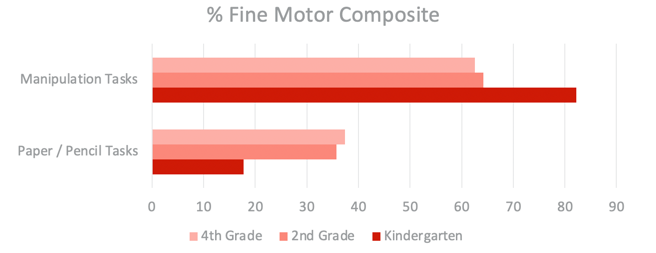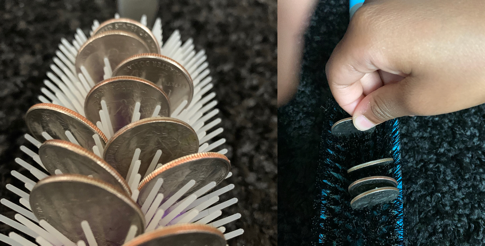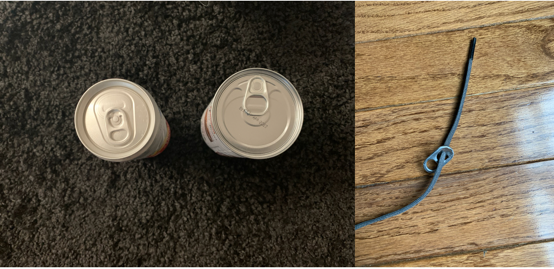Evidence
I have lots to share with you today. I would like to start out with a quote from this journal article: "Poverty is tied to structural differences in several areas of the brain associated with school readiness skills...development in these brain regions appears sensitive to the child's environment and nurturance (Hair, Hanson, Wolfe, and Pollak, 2015). What the child has in their environment as well as how they are nurtured in the home can cause structural differences in areas of the brain. "These observations suggest that interventions aimed at improving children's environments may alter the link between childhood poverty and deficits and cognition and academic achievement (Hair et al., 2015). The wonderful thing about this is that we, as OTs, can be a tool for altering this a child who is poverty-stricken to benefit in many different ways.
I wanted to start out with these quotes because today we are going to talk about household items that can be used for teletherapy, specifically for populations that have nothing. I received a lot of feedback from my last presentation on telehealth asking what to do for kids that have nothing at home.
In this AJOT article on occupational therapy practice guidelines for children and youth, "Practitioners should emphasize the use of activity- and occupation-based approaches to improve learning, academic achievement, and successful participation in school" (Cahill & Beisbier, 2020). We want to use actual activities and occupations to improve learning. We have evidence-based information to support that. We will also be looking at whether activities are activity-based or occupation-based.
Session Preparation
Therapist-Non-digital Material Suggestions
- Whiteboard
- Dry Erase Markers
- Books
- Coins
- Butter knives and/or other silverware
- Dark Colored Sharpie
Some non-digital material suggestions for a therapist would be a whiteboard, dry erase markers, books, coins, butter knives, and/or silverware. for example, for myself, I have my office silverware, which doesn't match and I'll show you a little bit later on what I like to do with that and a dark-colored sharpie because it shows up well on screen. these are things that you can have on your end that will help facilitate the teletherapy session.
Teletherapy Preparation
- Prior to the session, determine what materials the child has at home.
- Consider positioning needs: will the child need to or should the child complete this in supine? If so, determine what other activities can be completed on the floor or in the same position to decrease the need to move the streaming device.
- Use premade slides so that you can reuse them and don’t have to spend time manipulating the items.
Prior to the session, you want to determine what materials the child has at home. You can do that in a few different ways. You can do that with a scavenger hunt. For example, "What do you use to brush your hair, or "What is your favorite shirt?" "Show me your favorite toy or book." Something else that I like to have kids do so that they do not feel bad if they do not have an item is that I tell them we are going to work on a yes or no activity. "Do you have 'X, Y, and Z' at home?" The child then runs to find out. And if they do not have an item, they put it in the "No" column. This also gets them working on gross motor skills as they are running around the house in search of items. You can also have direct contact with the parents to find out what type of materials they have.
You also need to consider the positioning needs of the child. Should the child complete this activity in supine? Should they be on their back or in prone to do this activity? Should the child be in a tall kneeling position? You are taking into consideration what the child's abilities are at the time and then also what other things that they may be working on. If you are collaborating with other members of an IEP or treatment team, you may want to incorporate different strategies. In what position do you want the child to participate in these activities?
You may want to think about using pre-made slides. This way you can reuse them over and over, and you do not have to spend time manipulating the items. Depending on what type of activity you are doing, this might make your processes more streamlined instead of having to change your items around. Instead, you could say, "I would like you to do this." I will talk a little bit more about that as we get a little bit deeper into the presentation.
Materials Available at Home
- Scavenger hunt
- Home Tour
- Materials Bingo
- Get the information from the parents
- Parent checklist
- Conversation
- Ask the parent to send pictures
As I said, with the materials available, you can do a scavenger hunt. You can do a home tour. Of course, you want to make sure that the parent feels comfortable with that before offering that to your child. Often, my kids are excited to show you their home, their dog, room, et cetera. This is a way for you to get a good idea of what things may be available. Materials bingo is another great thing tool. Instead of the yes/no columns as I went over earlier, you can do materials bingo. There can be different items on the card like a brush, toothbrush, book, ball, or other different items. If the child has it, they can place like a bean or a ripped up piece of paper on the Bingo board. Or, you can do this electronically by having them put a check on the item. As I mentioned previously, getting information from the parents or giving the parents a checklist, can be helpful. I have had parents send pictures of the child's animals, favorite toys, or things like that to include in a fun activity. I can put it into a slide, and then, we can use that for further use. I actually had one child who loved his hermit crab. Mom sent me a cell phone picture of the hermit crab, and I used that as a writing prompt. It was cute, and he was excited to talk about Dinky, his hermit crab.
Material Considerations
- Do you want to reuse the item more than once?
- Is it also needed for daily use?
- How often will the item be available?
- How should the session be structured to get the most use out of the item?
- Are the items perishable?
There are materials that you can use more than once. An example would be an egg carton. I will show you later in the slides something you can do with soap. Is the family going to need that item (soap), or can we use that for a couple of weeks for the therapy session? How often will the item be available? I could give you different ideas, but these things may not always be readily available, especially food that is perishable. Or, maybe you want to use a shampoo bottle in an activity. However, you may need to wait until it is empty and available.
How should the session be structured to get the most use out of the item? We will look at that a little bit more later as well. You want to get the most use of an item. For example, you do not want to rip up the item before you use it to write on. It is a wasted opportunity to not use items multiple times. Again, is the item perishable? I do like to use food for therapy, but we also need to think about the progression for use. If you have the session around 11:30 right before lunch, that might be a good opportunity to use food.
Storage of Materials
- A shoebox
- Special drawer or cabinet
You also want to think about the storage of the materials. Where are they going to put these materials so that they are in a safe place for next week or for every session? Shoeboxes work great or they can put items in a special drawer. An egg carton may get tossed if not put away.
Therapy Considerations
- Engagement in daily occupations should remain the central focus of goals and intervention. Practitioners should use manualized programs that have clear activity- and occupation-based strategies as opposed to those that are solely focused on performance skills or client factors.
- Practitioners should collaborate with clients and caregivers to establish meaningful occupation-based and achievable goals and use intentional strategies to maintain a collaborative relationship throughout the therapy process.
(Cahill & Beisbier, 2020)
This AJOT article is from the occupational therapy practice guidelines for youth regarding engagement. Daily occupations should remain the central focus of goals and interventions. Practitioners should use manualized programs that have clear activity and occupation-based strategies, as opposed to those that are solely working on performance skills or client factors. We want to have a means to the end where it is working on something that the child is able to do functionally and not just building skills. Practitioners should collaborate with clients and caregivers to establish meaningful occupation-based and achievable goals and use intentional strategies to maintain a collaborative relationship through the therapy process. This is awesome when you are doing this in teletherapy because you are directly working with the clients and caregivers in their home environment as you can do a lot of occupation-based activities in their natural environment.
- Consistent caregiver training and instruction should be provided to promote carryover, and the power of the caregiver to affect change and support the child should be emphasized.
(Cahill & Beisbier, 2020)
Another consideration is consistent caregiver training. Instruction should be provided to promote carryover. The power of the caregiver to affect change and support the child should be emphasized. Once again, this is a wonderful thing as we are in the home already. Children may reside in impoverished households. Parents may have difficulty with nurturing the special needs of their children. We can model these different types of things to show them how this might work in their environment.
- “Interventions for children younger than age 3 should actively include parents during interventions and in-home program development.”
(Tanner, Schmidt, Martin, & Bassi, 2020)
Interventions for children younger than three should actively include parents during interventions in the in-home program. The wonderful thing about teletherapy is that we can include the caregivers. I want you to take a look at this slide (Figure 1). This is looking at fine motor activities in classrooms-- paper-and-pencil versus manipulation tasks. This comes from a replication study that was done.

Figure 1. Classroom performance of fine motor activities: Paper-and-pencil versus manipulation tasks. (Caramia, Gill, Ohl, & Schelly, 2020).
You can also find this article in AJOT. Although there is so much technology in schools, you can see that children are still doing paper-and-pencil tasks. In fact, they are spending a significant amount of their day doing tasks that involve fine motor manipulation. It is then certainly appropriate to continue to work on these activities in the home, even though we are using technology for our mode of service.
Activities for Fine Motor
Stand the Coins
You can stand coins in brushes. You can have the child go and grab a brush they have in the first session. Figure 2 shows two different types.

Figure 2. Types of brushes.
These are two that I have in my house, and they work great for standing up coins. If you have a child that has putty or PlayDoh at home, you can al have the child stand them inside of that as well. This works well with teletherapy if you angle the camera on the child's hand. Many of you are using Zoom, Google Meet, and FaceTime. If I am using either Zoom or Google Meet, I will use a second camera. You can sign in to the room with your cell phone if you want or another device. Have the phone pointed towards your hands. It can be a little bit tricky, but there are things around the web for helping with those cameras. I have seen a few people use the Osmo camera. With your cell phone or iPad, you can angle towards your hands. Or, if you mounted it on something, you can use your phone or iPad towards your face because it is already shooting towards you. If you are using a laptop, you can use the laptop bent down and pointing towards your hands if that is a little bit easier for you. Certainly, signing in with a second camera will allow the child to watch you demonstrate the task. You can also make a slide show to show the child step-by-step what to do. You can verbally give those directions out to the child.
Another idea is using coins and an egg carton. You can make a homemade Mancala game and use the coins or beans for that. This can also be used for sorting. With an egg carton, you can also play tic-tac-toe by using nine of the openings. You can have the child add in the bean or add in the coin for you. Again, you would angle the camera towards their hand while they are doing everything on their end.
Stringing "Beads"
- String Alternates
- Shoelace
- Q-tip
- Uncooked Spaghetti
- Bead Alternatives
- Pull tabs
- Cheerios
- Keys
- Buttons
Stringing beads is another great alternative. String alternatives include shoelaces, Q-tips, and uncooked spaghetti. Bead alternatives would be pull tabs, cheerios, keys, buttons, et cetera. In Figure 4, you see tabs from a drink and a shoelace that I had in my house. I strung the tab through the shoestring.

Figure 3. Examples of items in the author's house.
You can grade this activity by having them string it through the smaller hole. The one thing is that the string can get stuck in the smaller hole as it is not as smooth as the larger one. This is another activity where you want to have the camera angled down towards the shoe. Or, for example, you can show this in a slide while you are instructing the child (and parents if needed) on which hand the strings should be in (nondominant vs. dominant).
Q-tip/Hair Clips
In Figure 4, I am using a hair clip, a bobby pin, and one of the tabs to work on fine motor skills.
